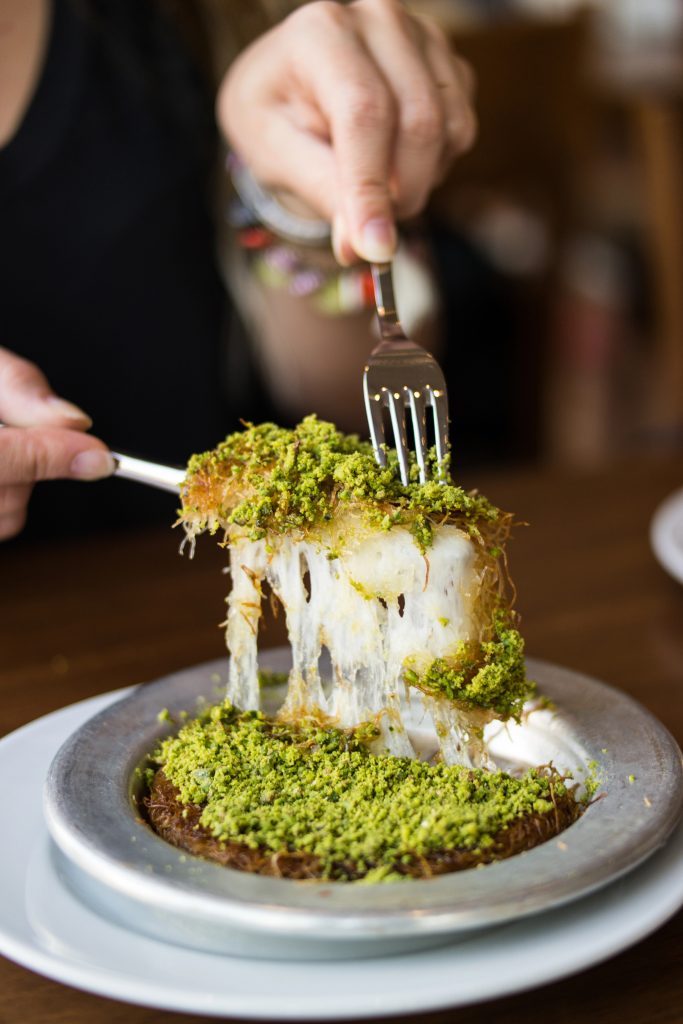
If there’s one dessert that captures the heart and soul of Middle Eastern flavors, it’s kunafeh.
This syrup-drenched, cheese-filled delight has a way of drawing people in with its unique texture, vibrant colors, and unforgettable taste. Whether you’re a longtime fan or new to this world of sweets, kunafeh promises a taste experience like no other—rich, aromatic, and filled with the warmth of tradition.
Dive in with us as we explore the story of kunafeh, its many varieties, and the special ways to enjoy it right here at Ottawa Kabab.
The History of Kunafeh: Origin and Evolution
Kunafeh, a beloved Middle Eastern dessert, is believed to have originated in Nablus, Palestine, with roots dating back to the 10th century during the Ottoman Empire. According to legend, it was first crafted by Nabulsi bakers as an energy-dense meal to sustain those observing Ramadan. Some accounts trace its origins even further, back to the Umayyad era, when it was considered a royal delicacy. While the true origins may be difficult to confirm, Nablus is widely recognized as the birthplace of kunafeh, specifically the classic kunafeh Nabulsieh, renowned for its authenticity and deeply intertwined with local culture.

Today, kunafeh is much more than a dessert; it’s a cherished piece of Middle Eastern heritage. Known as kunafeh Nabulsieh in Palestine and Syria, and later embraced in Turkey as knafeh, it has traveled across the region, evolving with each culture it touched. Each variation brings unique flavors and techniques, reflecting the diversity of the Middle East.
Kunafeh has become a centerpiece at celebrations across the region, from weddings to family gatherings, enriching holiday feasts with its sweet, syrup-soaked layers. Its appeal lies in its adaptability—whether enjoyed at a bustling city café or made at home with local ingredients, kunafeh remains an irresistible and enduring symbol of Middle Eastern tradition and flavor.
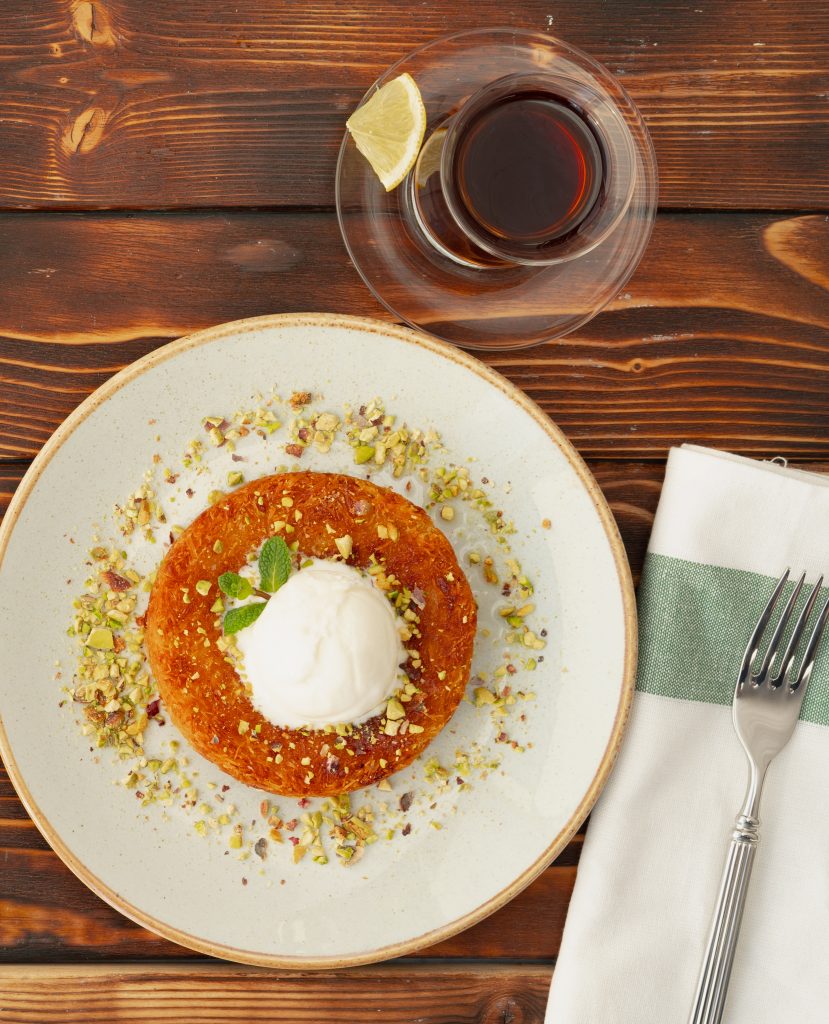
Kunafeh, Kunafe, Knafeh: A Matter of Pronunciation
Kunafeh’s name alone speaks to its diversity. Known as “kunafe” in Palestine and “kunafeh” in Syria, it takes on various names across the region, including “knafeh” in Turkey. These variations aren’t just phonetic quirks; they reflect the regional identities and culinary traditions that have shaped these iconic desserts. Syrians, for example, pronounce it with a soft “kunafeh,” emphasizing the smooth texture of their version. Palestinians add an extra “a” sound, echoing the warmth and family focus of their gatherings. Turks, on the other hand, call it “knafeh,” often adding their own flair with ingredients and preparation techniques.
These differences remind us that kunafeh is not just a dessert but a regional expression, with each pronunciation capturing a unique part of Middle Eastern identity.
Types of Kunafeh: A Regional Delight
The appeal of kunafeh is that it isn’t a one-size-fits-all dessert. Each region has developed its own signature style, putting a unique twist on the dish. Here are some of the most popular varieties:
- Syrian Kunafeh: Renowned for its smooth top and perfectly roasted red-brown crust, Syrian kunafeh is made with stretchy Akawi cheese, giving it a savory richness that contrasts beautifully with the sweet syrup. The careful roasting creates a golden, slightly crispy layer on top, offering a satisfying texture in every bite.
- Palestinian Kunafeh: Similar to the Syrian version, Palestinian kunafeh is often topped with a bright orange color, giving it a vibrant look that’s eye-catching. This kunafeh is also smoother but less roasted, allowing the flavors of the cheese mixture to take center stage. It may include flour and milk in the cheese mixture, adding a hint of creaminess.
- Turkish Kunafeh: Known for its harsher texture, Turkish kunafeh is typically made with rougher dough strands that deliver a distinct crunch. This texture contrasts beautifully with the soft, gooey cheese beneath, creating an experience that’s both hearty and satisfying.
Regardless of the style, one ingredient remains consistent: pistachios. Traditionally, kunafeh is sprinkled with crushed pistachios to add a nutty flavor and a dash of vibrant color. Some also enjoy it with a dollop of heavy cream or a scoop of ice cream on the side, adding even more layers of indulgence to the experience.
Kunafeh Trends: The Chocolate Twist and the Dubai Bar
Kunafeh is timeless, but that doesn’t mean it hasn’t seen exciting modern twists. In recent years, pastry shops across the Middle East have introduced a chocolate kunafeh, swapping out the traditional cheese filling for decadent chocolate. This rich, sweet variation has quickly gained popularity, particularly among younger generations looking to enjoy a modern take on a classic.
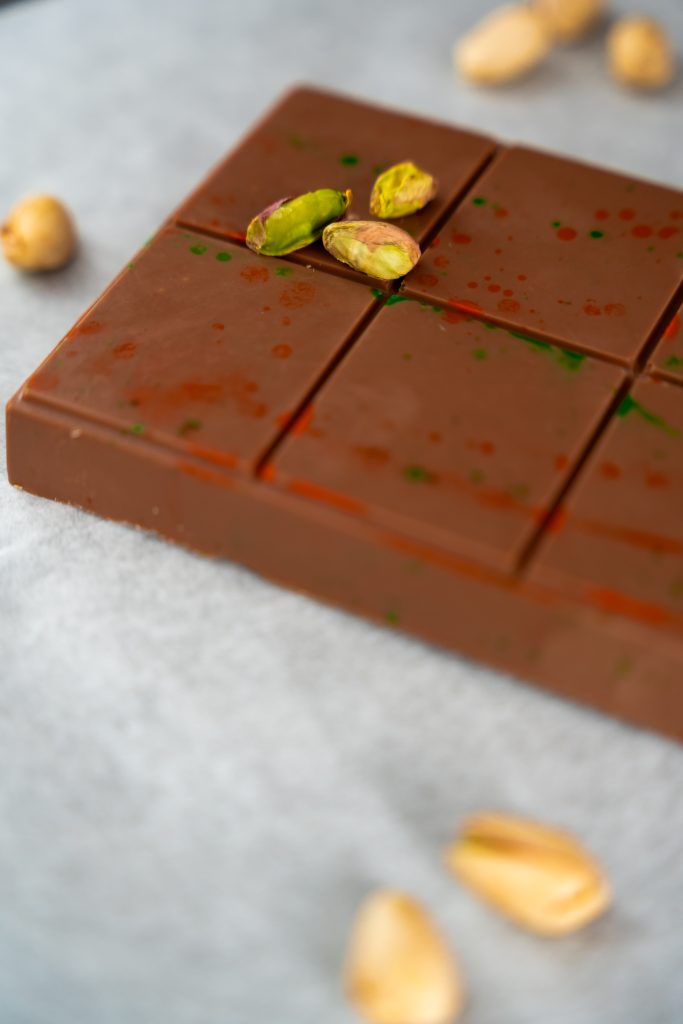
The latest kunafeh trend to take the world by storm is the Dubai bar, introduced in 2024. This innovative treat is a chocolate bar stuffed with kunafeh filling, merging the best of both worlds—chocolate and kunafeh. Its popularity skyrocketed on social media, quickly making its way into pastry and chocolate shops worldwide including Crown Pastries in Canada. The Dubai bar showcases how kunafeh’s classic flavors can evolve and adapt to new trends, all while maintaining its deep connection to Middle Eastern tradition.
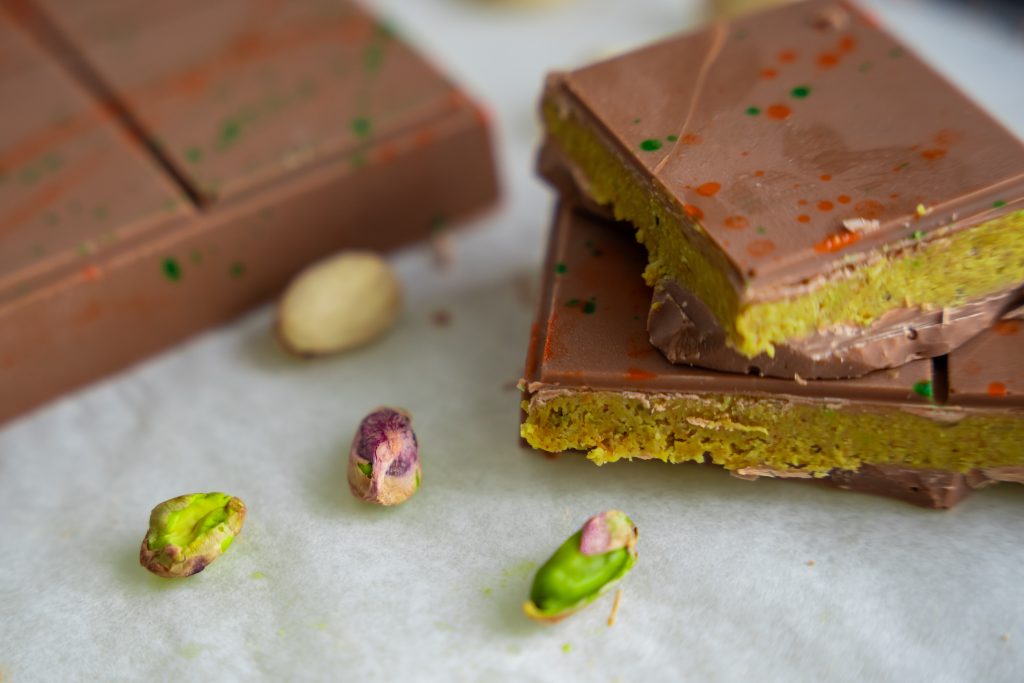
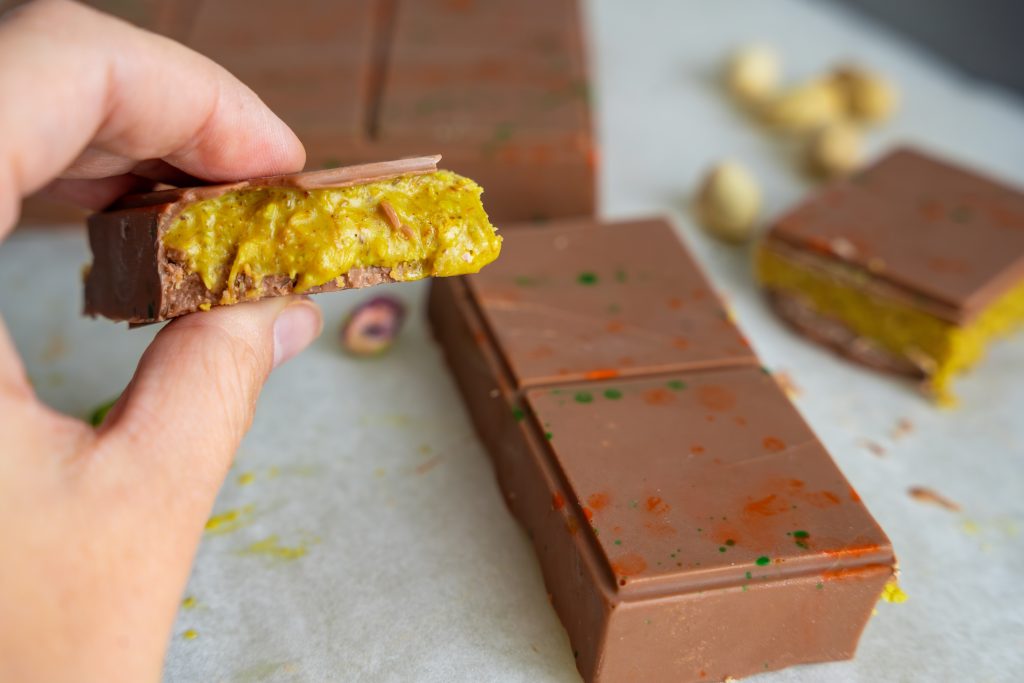

Kunafeh’s Events
Kunafeh isn’t just a dessert; it’s a tradition that symbolizes hospitality, warmth, and family. Across the Middle East, kunafeh is often served during special occasions such as Ramadan and Eid. Families gather to break their fast with kunafeh, savoring its rich, sweet taste together. Weddings, too, frequently feature kunafeh, where it is shared as a symbol of unity and shared joy. In many ways, kunafeh embodies the spirit of togetherness and community that defines Middle Eastern culture, offering a taste of home to those both near and far.
This cultural resonance makes kunafeh a dessert with a story—one that continues to be told with each gathering and every celebration.
Kunafeh Pairing: The Perfect Cup of Black Tea
For those looking to experience kunafeh at its finest, a pairing with black tea is highly recommended. Black tea, served without sugar, provides the ideal contrast to kunafeh’s sweetness, balancing its syrupy richness with a gentle bitterness. This classic combination enhances the flavors of both, allowing you to enjoy every bite and sip in harmony. Across the Middle East, kunafeh and black tea have become a staple pairing, perfect for an evening of relaxation or an after-dinner treat. Remember, no sure in your tea.
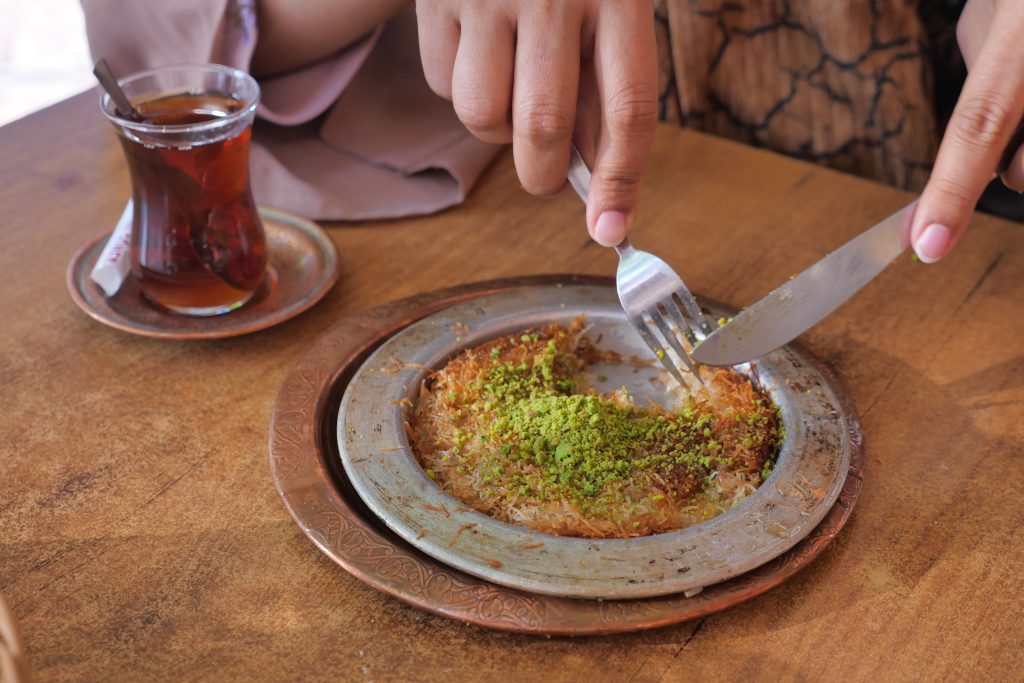
How to Enjoy Kunafeh in Canada
If you’re craving authentic kunafeh in Ottawa, we offers a variety of options to satisfy your taste buds. Whether dining in, ordering for delivery, or catering for an event, Ottawa Kabab provides a kunafeh experience that brings the flavors of the Middle East to Ottawa. Our kunafeh is made with traditional ingredients and prepared with the care and attention to detail that make this dessert so beloved.
For those interested in a warm, freshly baked kunafeh at home, look for pre-made kunafeh in Canada that can be baked right in your own oven for a delightful homemade experience.
For DIY lovers, try this Kunafa recipe, it provides an easy-to-follow guide for those eager to try making kunafeh from scratch. Ottawa Kabab makes it easy to enjoy kunafeh in any way you like—whether you’re savoring it with family, sharing it at a gathering, or treating yourself to a solo indulgence.

